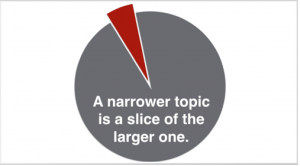Chapter 4: Reading & Writing
Mina’s Story
Mina is doing an internship at a small press. Authors and agents submit children’s books for potential publication and Mina is responsible for reading them all and passing on the most promising ones to the editorial team. One day, the head editor says that she is frustrated by the lack of diversity in the children’s book manuscripts that she is receiving. She asks Mina to do some research about the problem.
Mina isn’t sure where to start. The topic of diversity in children’s book publishing is huge. She begins by doing some background research. A Twitter thread leads her to an article about how 50% of main characters in children’s books are white, 27% are animals, and only 23% are BIPOC characters.[1] Then, she looks at the submission history for her press for the last few months and realizes that the breakdown is pretty similar.
Mina narrows her research question from “diversity in publishing” to “How can our small press encourage more diverse submissions?” Narrowing the question was only possible because she did some initial research. If she’d found that the press received diverse submissions but only accepted books with white main characters, her research focus would be totally different. Her question is now both more manageable (which will save her time) and more useful.
From there, Mina does the following research:
- Reads articles about how other presses have encouraged more diverse applications.
- Follows some popular BIPOC authors on Twitter and learns about some of the challenges they’ve faced in the publishing industry, and interviews a few.
- Discovers that disabled authors face additional barriers and identifies this as an untapped market.
- Interviews a few agents to get their perspective.
- Looks at the website copy for different presses and realizes that her press’ website copy could be more inclusive.
- Writes a short report outlining her findings.
As you can see, a specific research question allowed Mina to save time and also made sure that she was asking the right questions. Mina also kept an open mind throughout the process. She didn’t go looking to prove her own theories, and was open to being surprised. She hadn’t thought about disability, but her research led her to this area. The result: her editor was able to use her research to make positive changes within the press.
Why Narrow a Topic?
Once you have a need for research—say, an assignment—you may need to prowl around a bit online to explore the topic and figure out what you actually want to find out and write about. For instance, maybe your assignment is to develop a poster about “spring” for an introductory horticulture course. The instructor expects you to narrow that topic to something you are interested in and that is related to your class.

Ideas about a narrower topic can come from anywhere. In this case, a narrower topic boils down to deciding what’s interesting to you about “spring” that is related to what you’re learning in your horticulture class and small enough to manage in the time you have.
One way to get ideas would be to read about spring in Wikipedia, looking for things that seem interesting and relevant to your class, and then letting one thing lead to another as you keep reading and thinking about likely possibilities that are more narrow than the enormous “spring” topic. (Be sure to pay attention to the references at the bottom of most Wikipedia pages and pursue any that look interesting. Your instructor is not likely to let you cite Wikipedia, but those references may be citable scholarly sources that you could eventually decide to use.)
Or, instead, if it is spring at the time you could start by just looking around, admire the blooming trees on campus, and decide you’d like your poster to be about bud development on your favourites, the crabapple trees.
Background Reading
When you’re working on projects it’s wise to do some more reading about that narrower topic once you have it. For one reason, you probably don’t know much about it yet. For another, such reading will help you learn the terms used by experts who have studied your narrower topic. Those terms are certain to be helpful when you’re looking for sources later, so jot them down or otherwise remember them.
For instance, if you were going to do research about the treatment for humans with bird flu, this background reading would teach you that professionals and scholars usually use the term avian influenza instead of bird flu when they write about it. (Often, they also use H1N1 or H1N9 to identify the strain.) If you didn’t learn that, you would miss the kinds of sources you’ll eventually need for your assignment.
This initial reading could cause you to narrow your topic further, which is fine because narrower topics lead to greater specificity for what you have to find out. After this upfront work, you’re ready to start developing the research question(s) you will try to answer.
- https://www.slj.com/?detailStory=an-updated-look-at-diversity-in-childrens-books ↵

